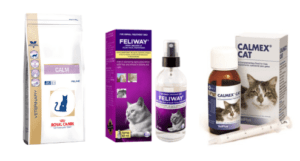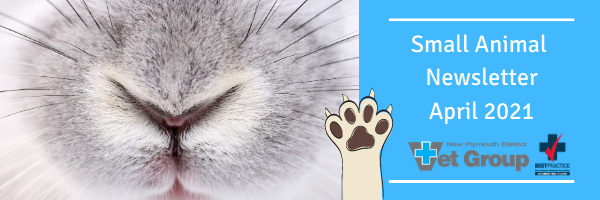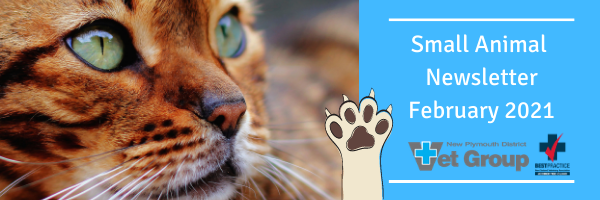We now offer Low Level Laser Therapy (LLLT also known as Photobiomodulation) Recently, we started offering…

Small Animal Newsletter – April 2020
Lockdown – A change for our furry friends
This lockdown has proven to be an unusual and stressful time – our furry friends included! They are so used to our ‘normal’ routine, and now suddenly that has changed. I’m sure the dogs are enjoying the extra walks; for some cats, this new routine will be quite stressful.
Here are some things you can do to help reduce stress for our feline friends.
- Keep their feeding time regime as normal as possible. Changing a cats mealtime can upset them and cause stress as they thrive on routine.
- If you have more than one cat, cats prefer to eat in their own bowl, so having a few feeding stations in different locations is recommended. (Cats don’t like to share).
- If you have children at home – it can be a good idea to allow your cat time away from the kids. This might mean allowing them to have a snooze in a spare room or a favourite place.
There are some excellent products available to helps cats with stress. We recommend the following:
Royal Canin Calm – this diet is designed to help reduce feline stress. It is a highly digestible, palatable, complete and balanced adult cat food which also includes two proven molecules. These molecules help assist with stress and emotional balancing. Alpha-casozepine (a peptide from milk) and L-tryptonhan, which is amino acid have proven benefits for anxious animals when combined. It also helps to eliminate hairballs – which is great for those cats that over-groom due to stress. For a full description, click here.
Feliway – a synthetic pheromone diffuser that emits happy cat pheromones, the same ones that cats produce from their cheek cells to rub onto objects to mark them as theirs. Feliway comes in a diffuser or a spray, and for best results, we recommend using both. Place the diffuser in the room where your cat seems to spend the most time and use the spray on areas where your cat likes to rub.
Calmex Cat – a calming supplement for cats. Calmex contains the essential amino acids L-theanine, which has calming properties, and L-tryptophan, which releases serotonin – the ‘happy chemical’ in your cat’s brain. Calmex also adds piper methysticum plant extract for more natural relaxing properties, while vitamin B supports a healthy central nervous system. Apply Calmex for cat twice daily to their food or directly into their mouth.
If you would like to purchase any of these products, call us and we can organise them for you to pick up or courier them to you.
Easter Hazards
During Easter time, we usually have an increase in chocolate toxicity cases at the clinic, and this is due to our cheeky pet’s thinking that they also deserve some chocolate treats. It’s no secret that dogs have an outstanding sense of smell, and this comes in handy when you are trying to hunt out the human easter egg stash.
Chocolate (Easter Eggs)
Chocolate contains a derivative of caffeine called theobromine. Dogs are unable to digest theobromine and ingestion can lead to hyperactivity, tremors, panting, racing heartbeat, vomiting, diarrhoea and seizures. Unfortunately, it can be fatal for some dogs. As a general rule, the darker the chocolate, the more toxic it is. If your dog has ingested ANY chocolate, big or small, you need to seek veterinary attention immediately. This way if we are able to make your dog vomit, we can prevent any nasty side effects. Not sure how much is too much when it comes to chocolate? Here’s a tool we use in the clinic – this handy chocolate toxicity calculator which shows how much chocolate is too much for a dog.
Xylitol and ‘sugar-free’ lollies:
Xylitol is an artificial sweetener often found in sugar-free foods, candies, baked goods, and mouthwashes. It rapidly increases insulin into a dog’s bloodstream, causing an extreme drop of blood sugar which can lead to liver failure. Be sure to keep any treats containing Xylitol out of the reach of paws.
Hot cross buns:
The sultanas and raisins in these delicious buns can cause acute kidney failure in dogs due to the possible presence of a toxin on the grapes. Keep these out of reach at all times and watch for any that happen to drop on the floor (a common issue if you have little children in the home)!
Decorative Grass (Plastic hay)
This popular decoration which is used in Easter baskets, plastic eggs, and little Easter toys can be very dangerous is eaten by your dog (or cat!) If you receive an Easter Egg hamper with decorative grass, dispose of it immediately in a bin that is out of reach from your pets.
Egg-sential tips
- Keep dogs away from an Easter egg hunt – they have been known to sniff them out before the children.
- Keep Easter eggs in a high place and behind shut doors.
- Be sure pets can’t get at the rubbish bag and snaffle up those leftovers!
As we are an essential business, our emergency services are available during Easter – so if your dog does accidentally eat some of your Easter egg treats – make sure you contact the clinic on (06) 7584006 immediately.
Animal Poison Centre Helpline
This month The Australian Animal Poisons Centre launched a helpline that is available to all New Zealand pet owners. They can assess your pet’s exposure and provide a risk assessment, treatment recommendations and referral advice if necessary. The service is free for all New Zealand pet owners.
Call: 0800 TOX PET (0800 869 738). Their current operational hours are 11AM-10PM (NZ time), and they are looking at extending these hours. You can follow them on Facebook @animalpoisonscentre
Why do cats have whiskers?

Whiskers are actually touch receptors. They are connected to the sensitive muscular and nervous systems, sending information about the surroundings directly to your cat’s sensory nerves, helping your cat to detect and respond to changes in its surroundings. Not only do their whiskers act as guidance, tracking and radar systems – you can also tell a lot about a cat’s mood from their whiskers. When a cat is resting or content, its whiskers will be mostly immobile. But if you see their whiskers suddenly bunch up and lay flat against the cat’s face – that may be a sign that the cat is scared.
A cat’s whiskers can also help them gauge whether they can fit into a tight space and serve as a way for cats to visually measure distance, which is why they can leap so quickly and gracefully onto a narrow ledge or out of harm’s way.
Cat’s whiskers should never be trimmed or cut off! Although they will grow back, without their whiskers, cats can become very disoriented and frightened.
Itchy dog?
It’s normal for your dog to itch and scratch itself occasionally, but if the itching is causing your canine distress or disrupting your household, it may be a case of ‘Itchy dog’, also known as ‘Canine itch’.
Potential causes
Several factors can cause and aggravate the itching. These include allergies, parasites or infections. Common allergies that are likely to cause problematic itching include:
- Food allergy
- Flea allergy
- Atopic dermatitis – an itchy skin disease brought on by environmental allergens such as house-dust mites, moulds and pollens
- Contact allergy – when itching is triggered by your dog coming into direct contact with something
Signs you should look out for:
A typical sign of your pooch having skin disease is behavioural change, or worse yet – their smell. You can watch out for important signs that may indicate you have an itchy dog. These include:
- Foot chewing
- Skin redness and hair loss
- Irritated, red or smelly ears
- Increased chewing, biting, scratching or licking
- Increased bottom scooting, rubbing or rolling
Why immediate action must be taken
It’s important you take your dog’s itching seriously. If they indeed have an allergic skin disease they will enter into an irritating repetitive cycle of itching and scratching. If you delay in addressing their itch sensation, the skin condition will become worse and can be harder to treat. Itching and inflammation can also lead to bacterial infections that need to be treated with shampoos and/or antibiotics.
If you suspect your dog is itching more than usual, contact us for some friendly advice or to book a consultation.
Staff Showcase
Head Surgery Vet Nurse – Nikki Klemra

She once spent 10 weeks devotedly caring for a dog called Nemo, who was healing from a broken back. After he recovered, Nikki adopted him and he has since been an important member of her family.
On the weekends, you’ll find Nikki hiking up the mountain or walking the beautiful beaches of Taranaki with Nemo. Not only does she ride horses but she also breeds and shows Arabian’s which keeps her pretty busy.
Bear and Bears!
Meet Bear! He belongs to our vet nurse Paige Miller. Bear is a Samoyed and we just thought this photo was too cute not to share. We hope your children have had fun finding all the bears in the windows during the lockdown!
Have you checked out our Instagram page yet? Updated daily – Meet our pet visitors and patients! Click here!
Disclaimer: This newsletter contains comments of a general nature only and is not intended to be a substitute for professional veterinary advice.









